Unraveling neutrino anomalies with (a lot of) oil at MiniBooNe
Neutrinos are intriguing beasts. By their sole nature, they indeed require the existence of some physics beyond the Standard Model of particle physics. Very recently, things become even more messy thanks to fresh results reported by the MiniBooNe experiment at Fermilab.
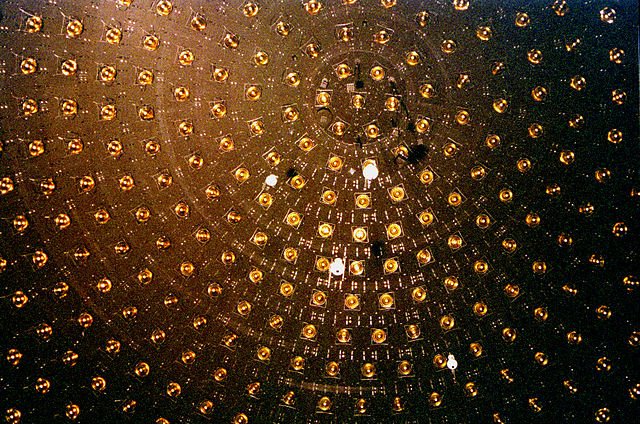
[image credits: Fred Ullrich (public domain)]
The MiniBooNe experiment is one of the numerous experiments currently harvesting information about the three neutrinos of the Standard Model,. thanks to a very oily detector.
The neutrinos are indeed known to be massive (see here), which has a lot of implications.
In particular this implies that neutrinos oscillate into each other when they propagate.
In other words, even if one prepares a beam of neutrinos of a given flavor (there are three of them to be precise), one could observe neutrinos of another flavor in a detector. New flavors can appear, and the original flavor can disappear.
This is the key principle behind most neutrino experiments: studying these disappearance and appearance of neutrino flavors.
Once again, an irrelevant thing is hidden in this post.
NEUTRINOS AND THEIR OSCILLATIONS
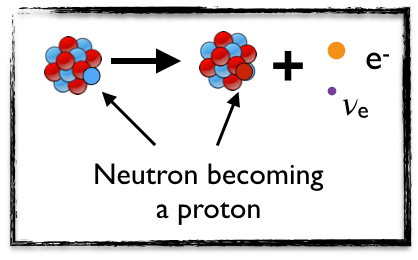
[image credits: homemade]
Neutrinos were introduced more than a century ago, when the first radioactivity studies were undertaken.
Data was pointing to the existing of an invisible particle produced through the beta decay of a given atomic nucleus into another nucleus and an electron (see the picture, the electron is the orange blob and the neutrino is the small pink one).
In 100 years, this phenomenon was theorized and is today known to be described by the theory of the weak interactions, that is itself fully included in the Standard Model of particle physics.
Today, we know that there are three neutrinos in the Standard Model, namely the electron, the muon and the tau neutrino. The symmetries underlying the Standard Model, taken together with the experimental constraints on the form of the neutrino interactions, moreover impose that neutrinos are massless.
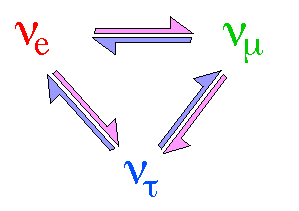
[image credits: Fermilab]
But the story does not end there.
The last two decades of experiments have demonstrated that neutrinos are messier that expected, and that the Standard Model should be extended to describe neutrino data.
Understanding neutrino physics represents thus a challenge for getting hints of how matter works at the most fundamental level.
Neutrinos are indeed massive, which implies they oscillate. A neutrino of a given type can turn into a neutrino of another type when it propagates. We can hence produce an electron neutrino in one place of Earth, and detect it as a muon or a tau neutrino a few hundreds of kilometers away.
THE MINIBOONE EXPERIMENT
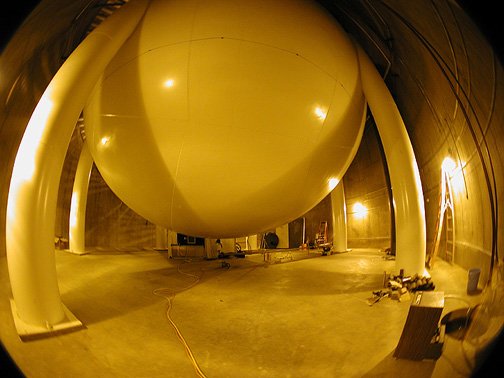
[image credits: Fermilab]
MiniBooNe consists in one of the experiments studying neutrino oscillations. The idea behind this experiment is pretty simple.
One first prepares a beam of quite energetic muon neutrinos from a bunch of hydrogen ions. This is achieved in several steps.
One begins with stripping the ions from their electrons so that one ends up with a beam of protons.
The protons are then smashed against a beryllium target, which generates a plethora of secondary particles including muon neutrinos originating from the decays of particles called pions.
The pions are arranged into a well-collimated beam thanks to a strong magnet, so that one ends with a beam of muon neutrinos aligned in the same direction, after getting rid of any other particle thanks to an absorber that absorbs everything but neutrinos.
The neutrino beam next reaches an oil detector of 800 tons lying 500 meters away from the source. A tiny (tiny tiny) fraction of all neutrinos will interact with the detector, and the observation of these interactions allows physicists to tag the nature of any neutrino that leaves a track in the detector.
The key point behind that is that the track of an electron-neutrino consists in an electron, the track of a muon neutrino consists in a muon and the track of a tau neutrino consists in a tau lepton.
The production of these three charged particles (the electron, muon and tau) yields different classes of shockwaves in the oil of the detector, and these shockwaves can be studied through a bunch of phototubes.
This hence allows physicists to get back to the flavor of the initial neutrino that generated a given shockwave.
DISCUSSION - THE MINIBOONE RESULTS AND THEIR CONSEQUENCES
The MiniBooNe detector can hence measure the rate at which muon neutrinos oscillate into electronic neutrinos. But why is it interesting? The reason lies in existing data.
Back in 1995, the LSND experiment reported evidence for muon to electron antineutrino conversion. These pieces of data were however incompatible with other neutrino experiment to a large extent.
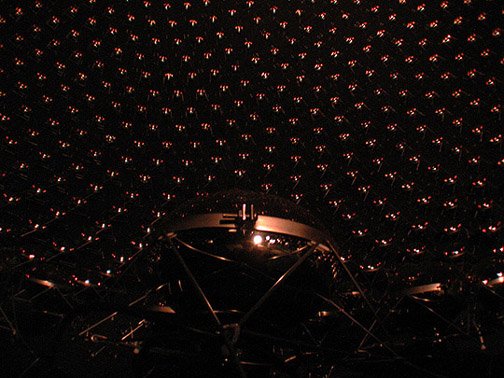
[image credits: Fermilab]
Therefore, these old measurements had to be confirmed. This is where MiniBooNe, and BooNe in the future, comes into the game.
If the LSND results are confirmed, our understanding of the laws of nature will be changed, as this would mean that there is probably a fourth species of neutrino.
Also, it may be very well that the issue is connected to the neutrino/antineutrino difference. The MiniBooNe experiment has therefore be designed to be able to distinguish neutrinos from antineutrinos.
This being said, the first results of the MiniBooNe experiments have been reported, and the anomaly has been confirmed.
Whilst this is definitely exciting, data is still consistent with standard neutrino oscillations. In other words, even if other neutrino models could provide a better fit to data, the standard one is not excluded yet.
To conclude, a neutrino mystery dating from almost 25 years is still very mysterious. New phenomena could be really there, and we may face the existence of a fourth neutrino species. However, data is not telling us whether this is the case yet, and I am afraid that the final words are ‘please stay tuned’.
STEEMSTEM
SteemSTEM is a community-driven project that now runs on Steem for almost 2 years. We seek to build a community of science lovers and to make Steem a better place for Science Technology Engineering and Mathematics (STEM). In particular, we are now actively working in developing a science communication platform on Steem.
More information can be found on the @steemstem blog, in our discord server and in our last project report.
to the moon, sensei
you are an honour to Steemit, pardon me for reading later
i am otherwise occupied
no no no
you are 200% added value
if only 5% reads it , you are still 200% added value
its much appreciated i wish i could do more
Thanks for the nice comment! Please take your time with the reading. You can always ask me questions later and I will answer no matter what (but you know that already ;) ).
i do, and thank you :) im catching up on a few weeks of replies
I first came in contact with neutrinos when I was writing my last post about the speed of light. There was an experiment that tried to prove that these particles could travel faster than light but it was later discovered that the scientists were actually wrong and the lead scientist, Antonio Ereditato, had to resign. The story was briefly narrated here
The experiment was not trying to proof they were traveling faster than light. This experiment, the OPERA experiment, was studying neutrino oscillation and the fact that tau neutrinos could appear. In 2011/2012, they measured something weird: neutrinos were apparently traveling faster than the speed of light in the vacuum, breaking the golden rule of special relativity. They didn't know why. After a year, it was found that a faulty connection made the measurements wrong (and special relativity was saved).
If you want to know more about the final results of OPERA, I can only recommend reading one of my last posts.
Oh thank you very much!
The pleasure was for me :)
How long for though ;)
This can be seen s a good and bad news at the same time. It depends on which side one stands ;)
Hi @lemouth!
This sounds very interesting!!
What is MiniBooNe, and BooNe? I didn't know about it! It will be very kind of you if you could please make me understand about it!! :)
This was really a very educative post and the explanation was really outstanding as always!! :)
BooNe is the final experiment and MinibooNe consists in its stage 1. As said in the post, this consists in one of the numerous experiments currently studying neutrinos. I assume you want to know more than in the post, but on what exactly (the question is very vague ;) ). Please specify and I will be happy to answer.
Thanks for the comment by the way!
Thank you so much for the kind reply @lemouth! I want to know about the BooNe experiment in short and easy manner as you always explained me. It attracted me to know more about it.
It will be very kind of you if you could please help me out with your valuable easy explanation!
The BooNe experiment will be built depending on the results of MiniBooNe. Depending on the findings, we will be able to calculate where to put a second detector for measuring what needs to be measured more precisely. It will work similarly to MiniBooNe. Is it clearer? You can fine more information here concerning the differences between the two.
Thank you so much for the explanation @lemouth!! I got it now.. :)
Thank you so much once again for the the time you taken out for clearing my doubt and making me understand!! The link you provided was quite helpful for me to understand more about the technology and the experiment!!
#Respect and #hatsoff to you for the courtesy you shown towards me!! :)
My pleasure, as always, and do not hesitate to come back to me anytime in case of any further question!
Sir I need some information related to it. I will message you in discord! :)
Anytime. I always answer (but please expect some delay).
I've often wondered how neutrinos are produced in beams and how scientists can direct them so precisely. Thanks for the explanation.

Joe
@joe.nobel
science fiction, fantasy, erotica
Thanks for passing by. To summarize, neutrino beams can be made by starting from a known reaction, and we then make sure that all the debris from that reaction are absorbed. One hence ends up with a beam containing only neutrinos.
But how do they get pointed from their source in (e.g.) Switzerland to a detector in Italy so precisely? And how can they tell that these particular ones are "your" neutrinos and not from some cosmic event or just from the sun?
The idea is to collimate the particles giving rise to neutrinos (pions) with magnets before they decay. In this way, the decay products (the neutrinos) will stay aligned within the beam.
There is a probability cosmic neutrinos are within the beam, bu this probability is very tiny. Remember, we need a very well defined energy, a very well-defined direction, etc.. This makes a lot of conditions.
Oh no! Is the neutrino going to break the holy tri-nity of elementary particles? ;-)
Maybe, maybe. Actually, this would be an interesting development. For now, one cannot exclude one hypothesis relatively to the other. But who knows, in months or years?
I always enjoy reading your posts. It's a refreshing thing to do on business trips.
Thanks! The next (or next-to-next) one will be on gravitational waves, for a weird reason ^^
Yeah, I really wonder why XD
When electron; for example; gets changed to muon during propagation, can they still change back to their original state - electron?
Be careful: electron neutrinos, not electron, can change flavor during their propagation. There is indeed a probability for a double flavor change. This is accounted for in the predictions.
Thanks for the correction and the kind response sir.
I am always happy to clarify things, don't worry :)
Thanks for sharing this information @lemouth. Regards.
The pleasure is for me! hanks for reading! :)
Hi @lemouth!
Your post was upvoted by utopian.io in cooperation with steemstem - supporting knowledge, innovation and technological advancement on the Steem Blockchain.
Contribute to Open Source with utopian.io
Learn how to contribute on our website and join the new open source economy.
Want to chat? Join the Utopian Community on Discord https://discord.gg/h52nFrV